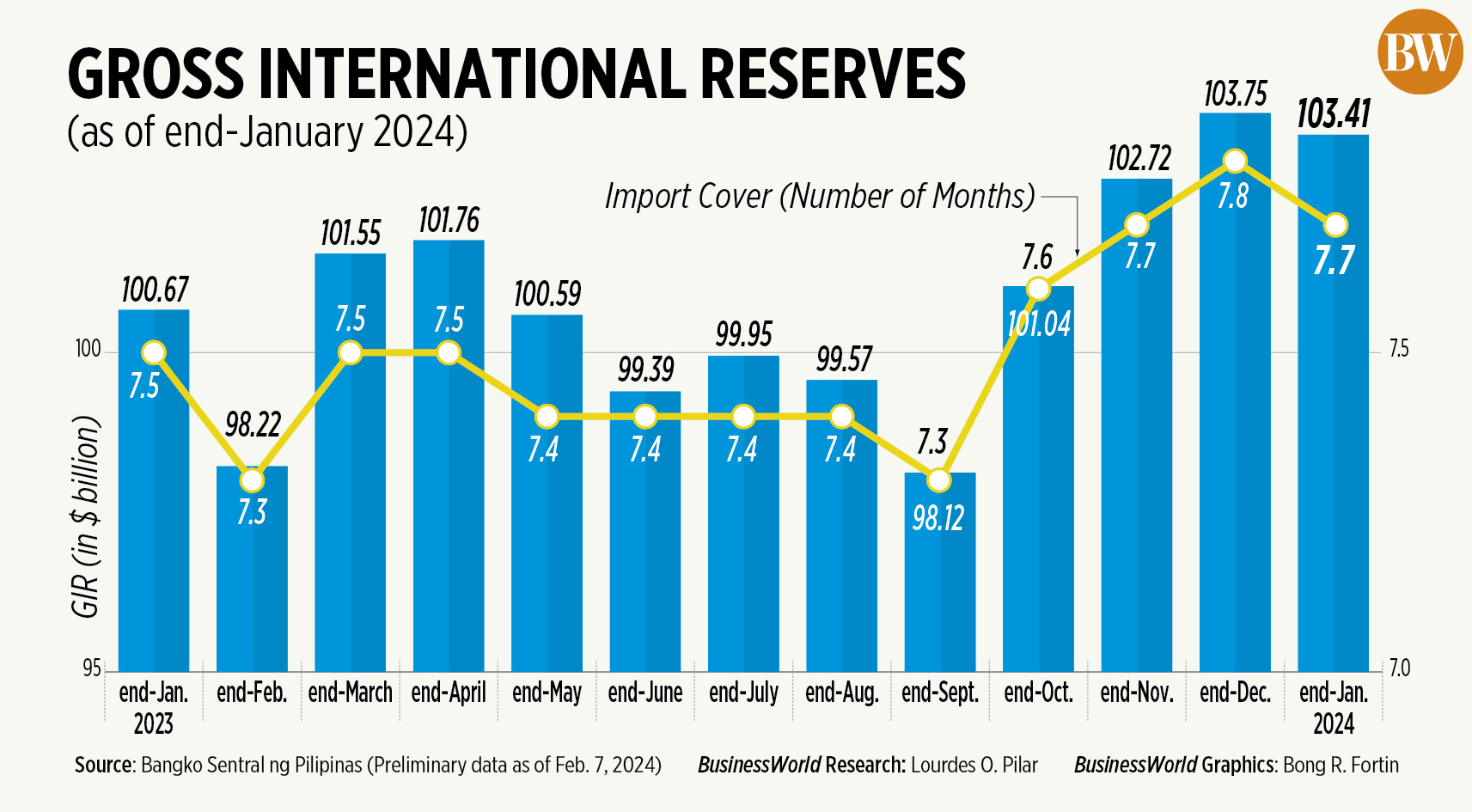[ad_1]
By Keisha B. Ta-asan, Reporter
THE PHILIPPINES’ gross international reserves (GIR) inched down in January following three straight months of growth as the National Government paid some of its debt.
Preliminary data released by the Bangko Sentral ng Pilipinas (BSP) on Wednesday showed reserves slipped by 0.3% to $103.41 billion from $103.75 billion at end-December 2023.
Year on year, dollar reserves rose by 2.7%.

“The month-on-month decline in the GIR level reflected mainly the National Government’s payments of its foreign currency debt,” the central bank said in a statement.
The BSP also attributed the lower GIR level to downward adjustments in the valuation of its gold holdings, as the price of gold in the international market fell.
“Despite the slight month-on-month decline, the GIR level remains at a sufficient level to support the country’s external obligations and to stem any excessive volatility and depreciation of the Philippine peso,” China Banking Corp. Chief Economist Domini S. Velasquez said in a Viber message.
GIR levels continue to be at the $100-billion level, which means the country has ample supply of foreign currency for any episodes of dollar liquidity shortage, ING Bank N.V. Manila Senior Economist Nicholas Antonio T. Mapa said in an e-mail.
“GIR has largely maintained these levels despite outsized concerns of GIR ‘depletion’ and we can expect it to remain at these levels for the rest of the year,” he said.
As of end-January, the level of dollar reserves was enough to cover about six times the country’s short-term external debt based on original maturity and 3.9 times based on residual maturity.
It was also equivalent to 7.7 months’ worth of imports of goods and payments of services and primary income.
Ample foreign exchange buffers protect an economy from market volatility and ensure the country can pay its debts in the event of an economic downturn.
The decrease in the country’s GIR was due to the month-on-month decline in foreign investments and the value of gold holdings, Rizal Commercial Banking Corp. Chief Economist Michael L. Ricafort said in a note.
The central bank’s foreign investments slipped by 0.5% to $87.39 billion as of January from $87.85 billion in the previous month. Year on year, foreign investments went up by 3.9%.
Reserves in the form of gold were valued at $10.3 billion, down by 2.5% from $10.56 billion as of end-December, but up by 5.1% from $9.8 billion a year earlier.
Mr. Ricafort said global gold prices rose to a record in late December, increasing by 1.1% month on month.
Meanwhile, foreign currency deposits surged by 49.4% to $1.15 billion from $770.7 million in the previous month. However, it fell by 45.7% from a year ago.
Net international reserves decreased by 0.9% to $102.8 billion from $103.7 billion a month earlier, the BSP said.
Net international reserves are the difference between the BSP’s reserve assets or GIR and reserve liabilities, such as short-term foreign debt and credit and loans from the International Monetary Fund (IMF).
The country’s reserve position in the IMF declined by 0.9% to $753.9 million at end-January from $760.9 million in the prior month and 5.4% from $797.3 million a year ago.
Special drawing rights — the amount the country can tap from the IMF — was unchanged at $3.809 billion for the second straight month. It was 0.2% higher year on year.
Ms. Velasquez said the country’s GIR might grow amid steady inflows from remittances, business process outsourcing revenues and tourism receipts.
“Anticipated rate cuts from the Federal Reserve will also likely result in a weaker US dollar and in turn, a stronger peso. This could be an opportunity to further build up reserves as a guard against peso volatility,” she said.
Mr. Mapa noted that the BSP would be less inclined to intervene in the foreign exchange (FX) market given its strong reserve position.
“We know that GIR is the first line of defense against episodes of tight dollar liquidity, but it is not the only line of defense,” he said.
“We believe there should be less anxiety over GIR depletion now that the BSP has demonstrated it continues to maintain a healthy and ample store of FX reserves on top of other existing dollar liquidity facilities,” he added.
In January, BSP Governor Eli M. Remolona, Jr. said the central bank would limit its intervention in foreign exchange markets and finalize a new framework this year.
The BSP also wants to make the peso more competitive by reducing restrictions in the FX market, he said.
Meanwhile, foreign borrowings by the government and the country’s largest companies could support the Philippines’ balance of payments position and GIR in the coming months, Mr. Ricafort said.
These include proceeds from foreign loans from commercial sources, multilateral agencies and official development assistance, he said.
“The National Government’s planned global bonds in the first half of 2024 would also be added to the country’s balance of payments and GIR data,” Mr. Ricafort said.
In January, former Finance Secretary Benjamin E. Diokno said the government was eyeing to launch an offering of foreign currency-denominated bonds in the first half amid expectations of easing interest rates.
The BSP expects the country’s GIR to hit $102 billion by end-2024.
[ad_2]







